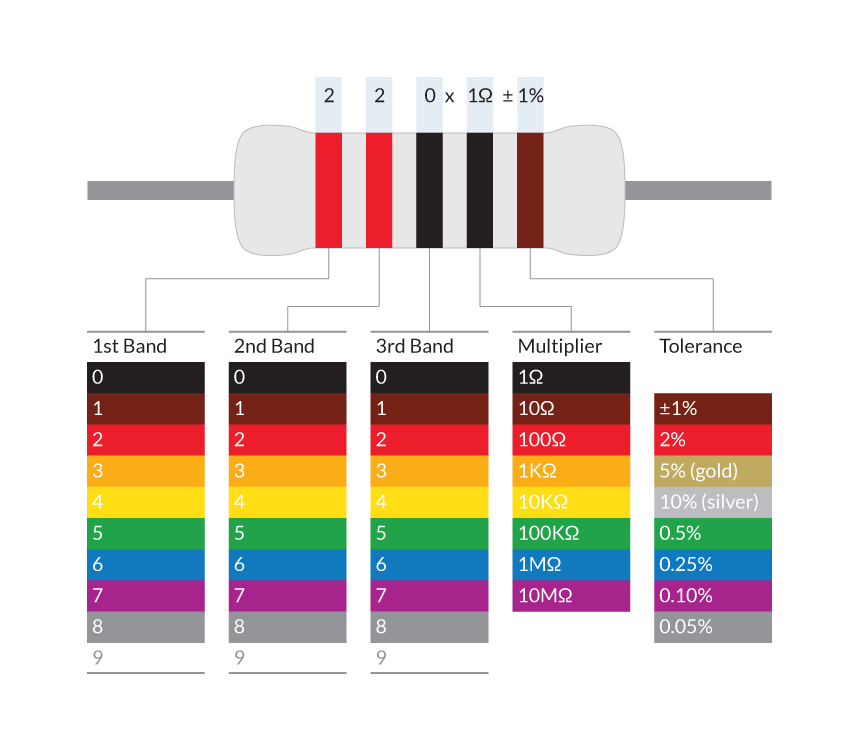Resistors find many uses in electronic equipment, and are impossible to avoid in prototyping. Resistors are passive electronic components which have a specific, constant electrical resistance. The resistor’s resistance limits the flow of electrons through a circuit. Commonly resistors are used to limit current, divide voltages, and pull-up of communication lines.
Resistors have two important properties (for other properties see datasheet).
- Resistance: the electrical resistance measured in ohm (Ω) or derived from this kilo ohm (kΩ; 1 kΩ = 1000 Ω) or Mega ohm (MΩ; 1 MΩ = 1000000 Ω). This value is given including a certain tolerance range expressed in percent (%)
- Power rating: the maximum power the resistor can dissipate without heating too much, measured in Watts (W). Resistors should be used without exceeding this maximum value. Common values are between 1/8 W = 0.125 W and 1 W. Resistors with higher power rating are usually referred to as power resistor.
Resistance values
Resistors have values coming from certain ranges e.g. E12 or E24 that are multiplied by powers of 10 e.g. 33 Ω, 330 Ω, 3.3 kΩ and so on.
E12 values (10% tolerance): 1.0, 1.2, 1.5, 1.8, 2.2, 2.7, 3.3, 3.9, 4.7, 5.6, 6.8, 8.2
E24 values (5% tolerance): 1.0, 1.1, 1.2, 1.3, 1.5, 1.6, 1.8, 2.0, 2.2, 2.4, 2.7, 3.0, 3.3, 3.6, 3.9, 4.3, 4.7, 5.1, 5.6, 6.2, 6.8, 7.5, 8.2, 9.1
Values are indicated on the outside of the resistors by means of colour bands. Always read the resistor bands with the tolerance band to the right. To distinguish the tolerance band, it is often clearly separated from the value bands, and usually it’ll either be silver or gold.
The 4 or 5 coloured bands on the resistor indicate the value according to the below figure. For 4 band resistors the 3rd band is the multiplier, for 5 band resistors the 4th band is the multiplier. On the internet you may find resistor calculators and apps that can help decode. Measuring using a multimeter is also an option of course
The power rating of resistors can be derived from the physical package size of the resistor. Standard resistors usually have ¼W or ½W power rating.
Basic Theory
The measurement unit of resistance is Ohms (Ω), named after Georg Simon Ohm who developed Ohm’s law: Voltage V equals Resistance R times Current I , or rewritten
$R =\frac{U}{I}$ and $I =\frac{U}{R}$
Power = Voltage * Current , or
$P ={U}\times{I} = \frac{U^2}{R}$
The lower the value of a resistor, the more current it will pass and the more power will be dissipated.
Parallel vs Series:
When two resistors ($R_1$ and $R_2$) are connected in series, the resulting resistance equals
$R_{series} = R_1 + R_2$
When two resistors ($R_1$ and $R_2$) are connected in parallel, the resulting resistance equals
$R_{parallel} = \frac{1}{\frac{1}{R1} + \frac{1}{R2}}$